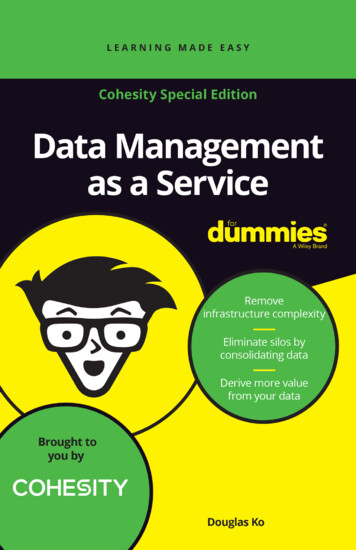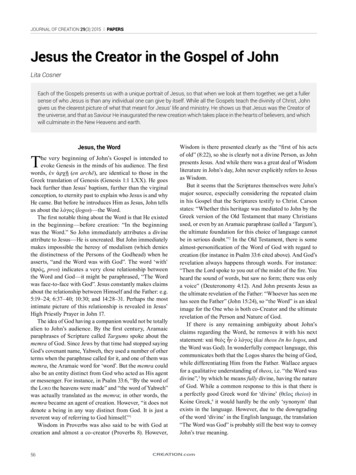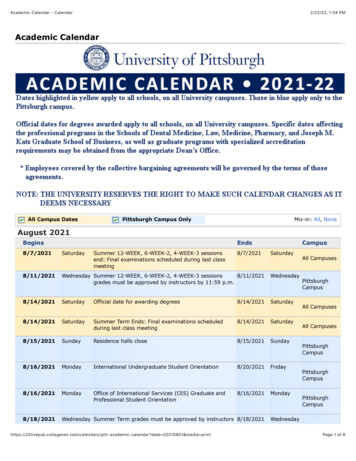
Transcription
These materials are 2021 John Wiley & Sons, Inc. Any dissemination, distribution, or unauthorized use is strictly prohibited.
DataManagementas a ServiceCohesity Special Editionby Douglas KoThese materials are 2021 John Wiley & Sons, Inc. Any dissemination, distribution, or unauthorized use is strictly prohibited.
Data Management as a Service For Dummies , CohesitySpecial EditionPublished byJohn Wiley & Sons, Inc.111 River St.Hoboken, NJ 07030-5774www.wiley.comCopyright 2021 by John Wiley & Sons, Inc., Hoboken, New JerseyNo part of this publication may be reproduced, stored in a retrieval system or transmitted in any form orby any means, electronic, mechanical, photocopying, recording, scanning or otherwise, except aspermitted under Sections 107 or 108 of the 1976 United States Copyright Act, without the prior writtenpermission of the Publisher. Requests to the Publisher for permission should be addressed to thePermissions Department, John Wiley & Sons, Inc., 111 River Street, Hoboken, NJ 07030, (201) 748-6011,fax (201) 748-6008, or online at http://www.wiley.com/go/permissions.Trademarks: Wiley, For Dummies, the Dummies Man logo, The Dummies Way, Dummies.com, MakingEverything Easier, and related trade dress are trademarks or registered trademarks of John Wiley & Sons,Inc. and/or its affiliates in the United States and other countries, and may not be used without writtenpermission. Cohesity, the Cohesity logo, and other Cohesity marks are trademarks or registeredtrademarks of Cohesity, Inc. in the U.S. and/or internationally. All other trademarks are the property oftheir respective owners. John Wiley & Sons, Inc., is not associated with any product or vendor mentionedin this book.LIMIT OF LIABILITY/DISCLAIMER OF WARRANTY: THE PUBLISHER AND THE AUTHOR MAKE NOREPRESENTATIONS OR WARRANTIES WITH RESPECT TO THE ACCURACY OR COMPLETENESS OF THECONTENTS OF THIS WORK AND SPECIFICALLY DISCLAIM ALL WARRANTIES, INCLUDING WITHOUTLIMITATION WARRANTIES OF FITNESS FOR A PARTICULAR PURPOSE. NO WARRANTY MAY BE CREATEDOR EXTENDED BY SALES OR PROMOTIONAL MATERIALS. THE ADVICE AND STRATEGIES CONTAINEDHEREIN MAY NOT BE SUITABLE FOR EVERY SITUATION. THIS WORK IS SOLD WITH THE UNDERSTANDINGTHAT THE PUBLISHER IS NOT ENGAGED IN RENDERING LEGAL, ACCOUNTING, OR OTHER PROFESSIONALSERVICES. IF PROFESSIONAL ASSISTANCE IS REQUIRED, THE SERVICES OF A COMPETENT PROFESSIONALPERSON SHOULD BE SOUGHT. NEITHER THE PUBLISHER NOR THE AUTHOR SHALL BE LIABLE FORDAMAGES ARISING HEREFROM. THE FACT THAT AN ORGANIZATION OR WEBSITE IS REFERRED TO INTHIS WORK AS A CITATION AND/OR A POTENTIAL SOURCE OF FURTHER INFORMATION DOES NOT MEANTHAT THE AUTHOR OR THE PUBLISHER ENDORSES THE INFORMATION THE ORGANIZATION OR WEBSITEMAY PROVIDE OR RECOMMENDATIONS IT MAY MAKE. FURTHER, READERS SHOULD BE AWARE THATINTERNET WEBSITES LISTED IN THIS WORK MAY HAVE CHANGED OR DISAPPEARED BETWEEN WHENTHIS WORK WAS WRITTEN AND WHEN IT IS READ.For general information on our other products and services, or how to create a custom For Dummies bookfor your business or organization, please contact our Business Development Department in the U.S. at877-409-4177, contact info@dummies.biz, or visit www.wiley.com/go/custompub. For information aboutlicensing the For Dummies brand for products or services, contact BrandedRights&Licenses@Wiley.com.ISBN 978-1-119- 82668-2 (pbk); ISBN 978-1-119- 82669-9 (ebk)Publisher’s AcknowledgmentsSome of the people who helped bring this book to market include the following:Development Editor: Ryan WilliamsProject Manager: Jen BinghamAcquisitions Editor: Ashley CoffeyEditorial Manager: Rev MengleBusiness Development Representative:Matt CoxContent Refinement Specialist:Vivek LakshmikanthSpecial Help: Chris Wiborg,Karen Logsdon Landwehr,Kristina Holmgren, andKaycee Carmichael-ChiuThese materials are 2021 John Wiley & Sons, Inc. Any dissemination, distribution, or unauthorized use is strictly prohibited.
Table of ContentsINTRODUCTION. 1About This Book. 1Foolish Assumptions. 2Icons Used in This Book. 2Beyond the Book. 2CHAPTER 1:Approaching a New Normal forData Management. 3Accelerating Digital Transformations. 4Making Sense of DMaaS?. 5A Modern Model. 6CHAPTER 2:The Mass Data Fragmentation Problem. 9What’s the Big Deal about Mass Data Fragmentation?. 10Facing Your Challenges. 11Data is fragmented. 11Data is inefficient. 12Data is dark. 13Not All SaaS Is Created Equal. 14Impacting Your Business. 15CHAPTER 3:Rethinking Your Data Management Strategy. 17Cloud-ify Your Strategy. 17The Hybrid World. 19A Platform for DMaaS and More. 21Spinning Up Backup as a Service. 24Do More with Your Data. 26CHAPTER 4:The Business Benefits of DMaaS. 29Move to More Predictable Costs. 29Consolidate Data Efficiently. 30Unlock Agility by Removing Complexity. 30Accelerate Cloud and Transformation Initiatives. 31Foster Innovation and Better Data Insights. 32Table of ContentsiiiThese materials are 2021 John Wiley & Sons, Inc. Any dissemination, distribution, or unauthorized use is strictly prohibited.
CHAPTER 5:Choosing the Right DMaaS Providerfor Your Business. 33Travelling on Your Cloud Journey. 33Building Your Business Case. 34Staying Flexible. 35Leaving One-Trick Ponies in the Stable. 36CHAPTER 6:Ten Use Cases for DMaaS. 39Offsite Backup and Recovery and BaaS. 39SaaS and Cloud Apps Protection. 40Long-Term Retention and Archiving. 41Disaster Recovery. 41Air Gap Security and Ransomware Recovery. 41Compliance and Data Governance. 42Files and Objects. 42Development and Test. 42Cloud Data Lake. 43Analytics. 43ivData Management as a Service For Dummies, Cohesity Special EditionThese materials are 2021 John Wiley & Sons, Inc. Any dissemination, distribution, or unauthorized use is strictly prohibited.
IntroductionThis book is about data. More accurately, this book is aboutactually managing data. Let’s face it — data serves enterprises the same way food serves people. Data powers learning and nurtures advantage. Data represents the lifeblood ofoperations. And we keep both generating and consuming data.As the amount of data explodes in and around your work, ITteams must help protect it from threats and extract those nuggetsof insight from it that can lead to new ways of doing something.With this knowledge, you can introduce a new idea to market ordisrupt an entire industry.Traditional approaches try to pull together all that growing enterprise data — structured and unstructured, including files andobjects, text and multimedia, and more — in ways that protect itand make it easy to see and reuse. But those methods just aren’tworking. And they’re starving businesses from making muchneeded digital gains, fast. Enter multicloud data management —and specifically data management as a service (DMaaS). Thiscloud-centric approach is a radically simple way to back up, secure,govern, and analyze all your data. Particularly the data hidden inthe far corners of IT systems that you might not even rememberyou had. Kind of like those skinny jeans from 20 years ago.So before we really dive deep into DMaaS, we’re going to talk aboutwhy there’s even a need to modernize data management. (Spoileralert: The answer is mass data fragmentation — but more on thatlater.) We’ll also address how and why a software-as-a-service(SaaS) model for data management can be your organization’sBFF. Finally, we’ll talk about choosing a provider and where tostart. That’s what this book is all about.About This BookIn a small footprint, we’ve packed a lot into this book to help youunderstand and explain the value of DMaaS not just to others inIT but to your business lines and executive leaders, too. Heck, youmight even be able to explain it to your mom. We cut through thetypical jargon to help you rethink this emerging model, set yourstrategy, and choose the right partner — all with the goal of putting your data at the service of your business.Introduction1These materials are 2021 John Wiley & Sons, Inc. Any dissemination, distribution, or unauthorized use is strictly prohibited.
Foolish AssumptionsIn writing this book, we’ve made some assumptions about you.We assume that:»» You work in IT and some have familiarity with data centersand their operations.»» You have some knowledge of backup and recovery products.»» You’re interested in cloud infrastructure, either multicloud,public, private, and/or hybrid models.Icons Used in This BookThroughout this book, we occasionally use special icons to callattention to important details. Here’s what to expect.This icon points out information you definitely need to know.This icon gets into the how something works: the nuts and boltsstuff.This icon points out suggestions that can make change easier.This icon is the early signal that something could go wrong — andhow to avoid it.Beyond the BookThe book is small, so think of it like a reference guide. Get theoverview and then keep it somewhere handy when you have toaddress new use cases. And if you need the latest-and-greatestinfo about DMaaS, check out cohesity.com/saas.2Data Management as a Service For Dummies, Cohesity Special EditionThese materials are 2021 John Wiley & Sons, Inc. Any dissemination, distribution, or unauthorized use is strictly prohibited.
IN THIS CHAPTER»» Understanding data management as aservice or DMaaS»» Transforming your data using the latesttools»» Implementing a modern datamanagement modelChapter1Approaching a NewNormal for DataManagementAs a service (aaS) has been gaining traction in enterprisesfor a while. You might be familiar with early entrants intosoftware applications (SaaS), platforms (PaaS), and infrastructure (IaaS) as a service. And during the pandemic wheneverything went digital first, cloud-based services really took off.Data management as a service (DMaaS) did, too.The move to aaS makes sense because people and IT teams don’talways like to regularly download software and manage thechange control cycle to keep it updated. And because someoneelse manages the operational infrastructure in a cloud-servicesmodel, IT teams can use aaS to cut complexity and better predict costs versus having to deal with hardware refresh and capitalexpenditure cycles.But the big driver behind aaS in general, and DMaaS in particular, is that it accelerates digital transformation. In this chapter,we look at how organizations get maximum choice and flexibility without having to manage data infrastructure: With a DMaaSsolution, that data infrastructure is managed for them.CHAPTER 1 Approaching a New Normal for Data Management3These materials are 2021 John Wiley & Sons, Inc. Any dissemination, distribution, or unauthorized use is strictly prohibited.
DMaaS is an umbrella term for organizations seeking easy accessto multiple data management capabilities, such as backup andrecovery, disaster recovery (DR), archiving, file and object services, dev/test provisioning, data governance, security, andanalytics — all provided as a comprehensive, integrated set ofofferings through a software-as-a-service (SaaS) model.Accelerating Digital TransformationsIn our digital, data-driven world, all organizations need datamanagement that is flexible, available, scalable, and reliable.DMaaS provides the answer to not only central IT operations, butline-of-business teams as well, with a radically simple way toback up, secure, govern, and analyze their data. All these benefits are offered by an expert provider, on an elastic, hyperscalecloud infrastructure. DMaaS helps you and your organizationfocus on the most important considerations as data continues togrow exponentially around you. In other words, you manage policies, service-level agreements (SLAs), and insights rather thaninfrastructure.When you remove the nonessential, day-to-day tasks and operational headaches that come from having fragmented data and therisks of having it exposed to cyberattacks, you can derive valuefrom your data that changes the way your business works — forthe better. (To find out more about data silos and mass data fragmentation, turn to Chapter 2.)When organizations radically simplify data management, they arefree to push away barriers and innovate. Retailers can collect andanalyze all of their data to improve the customer experience. Lifesciences companies leverage backup data to speed the development and testing of new applications while ensuring data visibility and reducing risk. And tech companies? Well, those lucky folksdrive further, faster, and more iteratively to disrupt traditionalways of working.No matter the industry, DMaaS radically simplifies how you manage your organization’s data across hybrid and multicloud environments. That way, you can easily unlock nearly limitless valuefrom all that data to accelerate the digital strategy you envision todrive your competitive edge forward.4Data Management as a Service For Dummies, Cohesity Special EditionThese materials are 2021 John Wiley & Sons, Inc. Any dissemination, distribution, or unauthorized use is strictly prohibited.
Making Sense of DMaaS?The debate about whether to move to the cloud is over. The number of enterprises counting on cloud is already over 90 percent,according to most analysts and company reports. And the number of enterprises pursuing a hybrid cloud strategy is somewherebetween 62 percent (according to 451 Research) and 87 percent(according to Flexera).Cloud business will be a 1 trillion market by 2024, says IDC. Sonow, it’s simply a matter of what workloads belong in the cloud.Richard L. Villars, group vice president, Worldwide Researchat IDC, says, “Cloud in all its permutations — hardware/software/services/as-a-service as well as public/private/hybrid/multi/edge — will play ever greater, and even dominant, rolesacross the IT industry for the foreseeable future. By the end of2021, based on lessons learned in the pandemic, most enterpriseswill put a mechanism in place to accelerate their shift to cloudcentric digital infrastructure and application services twice as fastas before the pandemic.”Modern data management is the simplest, best path to protect,connect, and unlock value in data spanning those hybrid — onsiteplus offsite — IT environments.Before we go any further, we should point out that DMaaS is notdatabase management nor a data-warehousing-as-a-servicesolution. These tools are often confused with DMaaS because teamsimplementing them also want to make the best use of their data.They’re focused on organizing a certain type of structured dataprimarily for analytical purposes. DMaaS covers a much broaderset of data types as well as a broad range of operational use cases.So what is DMaaS then? DMaaS is a portfolio of managed cloudofferings that provide comprehensive data management capabilities for multiple use cases (see Figure 1-1), including thefollowing:»» Backup and recovery»» Archiving»» Long-term retention»» Ransomware protection and recoveryCHAPTER 1 Approaching a New Normal for Data Management5These materials are 2021 John Wiley & Sons, Inc. Any dissemination, distribution, or unauthorized use is strictly prohibited.
»» Disaster recovery (DR)»» Data mobility»» Development and testing»» Compliance and governance»» File and object services»» AnalyticsDMaaS provides operational oversight for every kind of data youcollect, protect, and keep for future use. And that data comes asboth structured and unstructured; video and audio files, surveillance footage, virtual machines, persistent volumes, objects,and more.FIGURE 1-1: Bringing it all together.A good way to think about DMaaS is in the context of your datacenter modernization initiatives — many of which involve converged or hyperconverged infrastructure (HCI) stacks to simplify data center operations. That’s what DMaaS does for datamanagement functions. It consolidates many use cases on oneplatform — and does so in the cloud.A Modern ModelDMaaS is different from legacy data management approaches ina number of ways. First, to address a comprehensive set of usecases typically requires knitting together a series of silos. In abackup and recovery context, for example, you might encountervarious software for different data sources, plus media servers,tape libraries, and target storage all put together in a patchworkedsolution to operate and manage. And that old-school model istime consuming, error-prone, and costly.6Data Management as a Service For Dummies, Cohesity Special EditionThese materials are 2021 John Wiley & Sons, Inc. Any dissemination, distribution, or unauthorized use is strictly prohibited.
Second, each part of the puzzle, whether it’s backup, file andobject shares, or disaster recovery, is owned and sold by a different vendor. And working with three, four, or five of those is justplain exhausting. Imagine having to put together a car by ordering all of the separate parts — complete with separate assemblyinstructions. And third, forget about seamlessly extending to thecloud. That usually requires an entirely different set of gateways.A modern data management model eliminates data managementcomplexity and unifies operations on a single platform. Thisimplementation cuts out downtime and data loss. You realizespeedier operations — from backups to development and testingand analytics — while lowering total cost of ownership (TCO).And with DMaaS, you can manage data sources across data centers, the edge, and public clouds. Best of all, you can leverage allthat data for business value.With DMaaS, you drive agility by providing data managementon-demand. You get to focus on policies and SLAs instead ofinfrastructure. Innovate faster by easily and quickly giving yourdevelopers and analysts access to data that can be tapped byadvanced cloud services such as artificial intelligence and machinelearning (AI/ML).To find out more about the issues DMaaS solves, and why notall offerings (even some cloud and SaaS ones) are ideal for solving the underlying problem facing many organizations, turn toChapter 2.CHAPTER 1 Approaching a New Normal for Data Management7These materials are 2021 John Wiley & Sons, Inc. Any dissemination, distribution, or unauthorized use is strictly prohibited.
IN THIS CHAPTER»» Uncovering problems caused by datasprawl»» Understanding the massive impact»» Addressing your challenges with thecorrect solutionChapter2The Mass DataFragmentation ProblemAnalysts at Enterprise Strategy Group (ESG) recently framedthe problem DMaaS solves succinctly, writing: “Mass datafragmentation, global data fragmentation, and distributeddata fragmentation all refer to the same thing — by having primary and secondary data sets spread out all over the physical andvirtual enterprise, we spend far more time and money trying tomanage it than we get in return.”“By not having a centralized consistent view of data and easyaccessibility to data by any and all of our applications that requireit, we will never be able to maximize the value of our data,”says ESG.So it’s up to organizations to take action and address their datachallenges — especially the data operations parts of the IT complexity challenge. These efforts must address the problems posedby these disparate sources of data residing in a multitude of locations and infrastructure silos. This chapter examines this problemclosely and the challenges it creates so you can identify what’sneeded as a solution.CHAPTER 2 The Mass Data Fragmentation Problem9These materials are 2021 John Wiley & Sons, Inc. Any dissemination, distribution, or unauthorized use is strictly prohibited.
On average, midsize organizations believe they’ve lost nearly40 percent of deals to larger organizations that have a greater ability to manage and derive value from their data, according to a recent“State of Data Management Report” fielded by Vanson Bourne.A full 91 percent of midsize respondents think DMaaS will enablethem to compete more effectively against those larger enterprises.What’s the Big Deal about MassData Fragmentation?Mass data fragmentation results from the ever-growing proliferation of data and related infrastructure — across different locations, silos, clouds, and management systems — and preventsorganizations from fully utilizing that data’s value. This challengenegatively impacts data used in many different places and ways:»» Across data management use cases, such as backup,disaster recovery (DR), and file and object services»» Within data management use cases, such as backup and recovery»» Across organizational functions and departments, such asdevelopment and testing, IT operations, and cloud teams»» Across locations, such as data centers, remote offices, andpublic cloudsVisually, mass data fragmentation looks something like Figure 2-1.FIGURE 2-1: All that data, scattered everywhere.10Data Management as a Service For Dummies, Cohesity Special EditionThese materials are 2021 John Wiley & Sons, Inc. Any dissemination, distribution, or unauthorized use is strictly prohibited.
The fracturing of data elements into separate silos reduces opportunities to gain new insights and create more value from thatdata — all of which is needed if teams are thinking about disrupting an industry segment, let alone an entire industry itself.Each further fragmentation makes it harder for the organizationto get a truly comprehensive understanding of what data is available and complicates activities to analyze it.On top of siloed data elements, IT organizations typically runsiloed infrastructure for each use case. And each use case typicallyuses its own hardware, software, and separate management userinterface (UI). This infrastructure fragmentation increases operational costs and complexity. And this situation further creates acrisis of confidence in the data when no one can be sure his or hercopy of a data set is the “right” one to work with.Mass data fragmentation results from the ever-growingproliferation of data — across different locations, silos, clouds,and management systems — and prevents organizations fromfully utilizing that data’s value.Facing Your ChallengesIf you think your organization suffers from mass data fragmentation, keep reading. There are three really big issues your organization is dealing with because of it.Data is fragmentedThe world contains a lot of data already, and growth isn’t slowingdown anytime soon.By 2024, people around the world will have created, captured, copied, and consumed more than 149 zetabytes (ZB) of data, according to IDC’s “Worldwide Global DataSphere Forecast, 2020–2024:The COVID-19 Data Bump and the Future of Data Growth” report.And here’s the kicker — the amount of data created over thenext three years will be more than the data created over the past30 years, and the world will create more than three times the dataover the next five years than it did in the previous five.Phew! That’s a lot of data to manage. And organizations are putting it everywhere. People store their data on-premises — inCHAPTER 2 The Mass Data Fragmentation Problem11These materials are 2021 John Wiley & Sons, Inc. Any dissemination, distribution, or unauthorized use is strictly prohibited.
databases, applications, on servers, and more. People are alsostuffing data into clouds: private, public, and hybrid. Andorganizations are increasingly pushing data to the edge, embracingmobile devices from smartphones to tablets, as well as Internet ofThings (IoT) sensors and artificial intelligence/machine learning(AL/ML) platforms. Once more, there’s a kicker: Most of theselocations and solutions are architected by different providers thatrun separate infrastructure stacks and solutions that don’t talk toeach other, limiting visibility and control.Data is inefficientNot all data is valuable. Most growth is due less to organizationscreating original data and more to duplication of the data enterprises already have.The same IDC forecast of data growth mentioned earlier sayswe’re migrating toward less unique and more replicated data —analysts estimating a 1:10 ratio by 2024. That’s not only a lot ofduplicate data to be saving, but it’s also data that becomes morechallenging to oversee and reuse because people tweak it, thensave it again and again — on their own machines and on companyservers and then just for good measure, save it again in cloudenvironments. ESG in its “Mass Data Fragmentation Is QuietlyKilling Digital Transformation Efforts” report says the organizations it surveyed report a typical data set is copied and stored anaverage of six times.Take a look at a real-world example: A bank may have 1,000 client services staff members helping customers fill out loan applications that are completed online or digitized and then storedlocally and backed up to an offsite location. The bank’s 25-personmarketing department wants to use information that client services gathered to target customers with promotional materials,so that group copies the data, and lets the internal developmentteam build an app that it needs to support its campaign. The devteam then copies the data again, moving relevant parts offsite to acloud provider, to create and test a new marketing app running inthe cloud. And just like that, data becomes massively fragmented.And once that happens, data sharing between functions breaksdown; even worse, capacity is hard to optimize so teams have toprocure more space. And that takes not only more people, but12Data Management as a Service For Dummies, Cohesity Special EditionThese materials are 2021 John Wiley & Sons, Inc. Any dissemination, distribution, or unauthorized use is strictly prohibited.
specialists, to handle. They’re left to operate, manage, and coordinate multiple proprietary systems.Traditional data management products weren’t designed to scaleout and globally address duplication, and that’s not only inefficient, it increases risk. With data growing and duplication occurring more regularly, IT teams are quickly finding they have neitherthe people nor the operational power and budget to keep up.Data is darkThe “State of Data Management” study from Vanson Bournealso reveals that most IT departments spend around 40 percentof their time installing, maintaining, and managing data infrastructure. Some even say IT teams spend half to three-quartersof their time each week on these tasks. That’s because traditional products including backups weren’t architected for today’sdata-driven world and retrofitting them takes even more worksometimes.Some IT teams are spending on average five months a year grappling with data silos and complex infrastructure while battlingagainst budget tightening. As a result, data stays dark: Teamsdon’t know where data is stored, let alone know what they have.And guess what that leads to? You got it: increased complianceand security risks.Extra copies of data stored outside of the country of origin, too,can lead to hefty fines because organizations find themselves outof compliance with local and regional data privacy and residencylaws such as the European Union’s General Data Protection Rule(GDPR). Moreover, dark data sitting in improperly secured locations or storage devices can create vulnerabilities that are easilypenetrable by cybercriminals. And boy, are cyberattacks costly.But the negative financial impact
4 Data Management as a Service For Dummies, Cohesity Special Edition Any dissemination, distribution, or unauthorized use is strictly prohibited. DMaaS is an umbrella term for organizations seeking easy access











